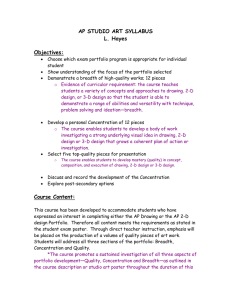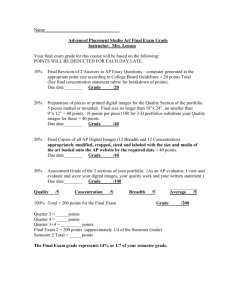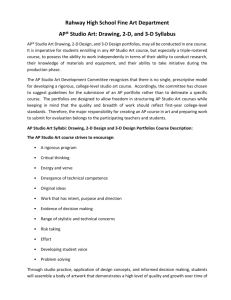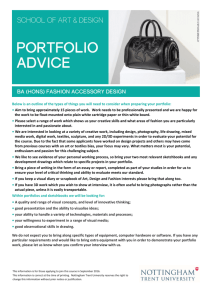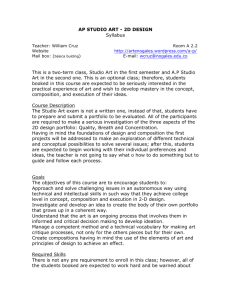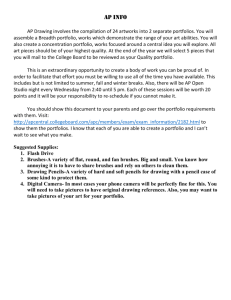AP® Studio Art: 2-D Design Portfolio Syllabus
advertisement
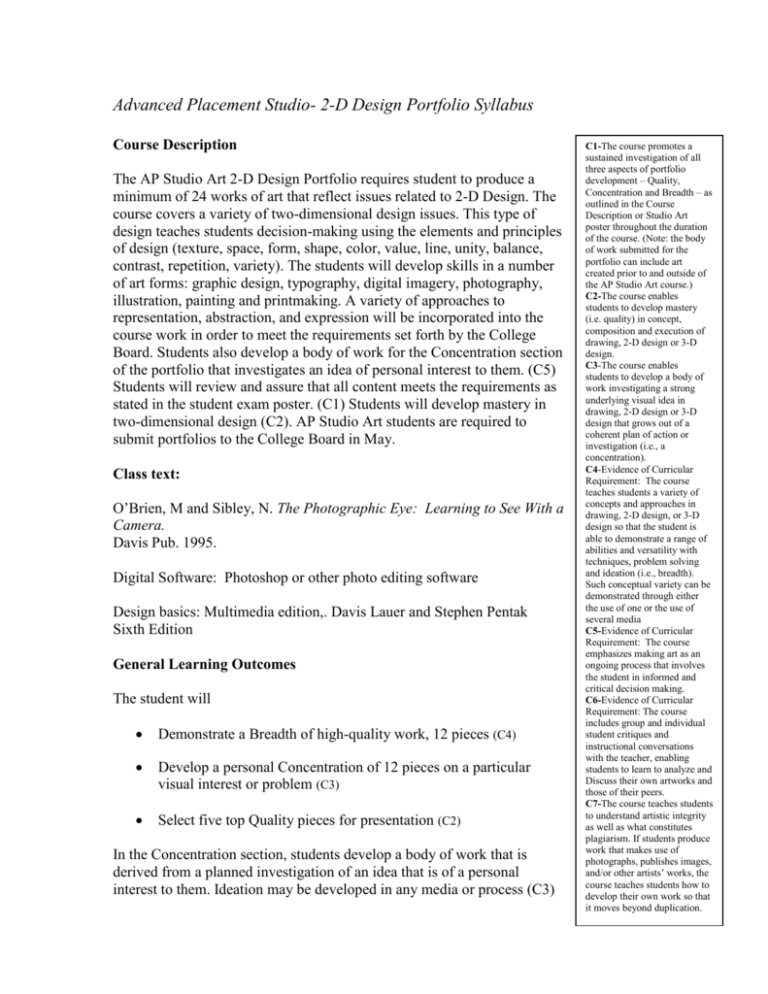
Advanced Placement Studio- 2-D Design Portfolio Syllabus Course Description The AP Studio Art 2-D Design Portfolio requires student to produce a minimum of 24 works of art that reflect issues related to 2-D Design. The course covers a variety of two-dimensional design issues. This type of design teaches students decision-making using the elements and principles of design (texture, space, form, shape, color, value, line, unity, balance, contrast, repetition, variety). The students will develop skills in a number of art forms: graphic design, typography, digital imagery, photography, illustration, painting and printmaking. A variety of approaches to representation, abstraction, and expression will be incorporated into the course work in order to meet the requirements set forth by the College Board. Students also develop a body of work for the Concentration section of the portfolio that investigates an idea of personal interest to them. (C5) Students will review and assure that all content meets the requirements as stated in the student exam poster. (C1) Students will develop mastery in two-dimensional design (C2). AP Studio Art students are required to submit portfolios to the College Board in May. Class text: O’Brien, M and Sibley, N. The Photographic Eye: Learning to See With a Camera. Davis Pub. 1995. Digital Software: Photoshop or other photo editing software Design basics: Multimedia edition,. Davis Lauer and Stephen Pentak Sixth Edition General Learning Outcomes The student will Demonstrate a Breadth of high-quality work, 12 pieces (C4) Develop a personal Concentration of 12 pieces on a particular visual interest or problem (C3) Select five top Quality pieces for presentation (C2) In the Concentration section, students develop a body of work that is derived from a planned investigation of an idea that is of a personal interest to them. Ideation may be developed in any media or process (C3) C1-The course promotes a sustained investigation of all three aspects of portfolio development – Quality, Concentration and Breadth – as outlined in the Course Description or Studio Art poster throughout the duration of the course. (Note: the body of work submitted for the portfolio can include art created prior to and outside of the AP Studio Art course.) C2-The course enables students to develop mastery (i.e. quality) in concept, composition and execution of drawing, 2-D design or 3-D design. C3-The course enables students to develop a body of work investigating a strong underlying visual idea in drawing, 2-D design or 3-D design that grows out of a coherent plan of action or investigation (i.e., a concentration). C4-Evidence of Curricular Requirement: The course teaches students a variety of concepts and approaches in drawing, 2-D design, or 3-D design so that the student is able to demonstrate a range of abilities and versatility with techniques, problem solving and ideation (i.e., breadth). Such conceptual variety can be demonstrated through either the use of one or the use of several media C5-Evidence of Curricular Requirement: The course emphasizes making art as an ongoing process that involves the student in informed and critical decision making. C6-Evidence of Curricular Requirement: The course includes group and individual student critiques and instructional conversations with the teacher, enabling students to learn to analyze and Discuss their own artworks and those of their peers. C7-The course teaches students to understand artistic integrity as well as what constitutes plagiarism. If students produce work that makes use of photographs, publishes images, and/or other artists’ works, the course teaches students how to develop their own work so that it moves beyond duplication. Students will use informed decision-making and problem-solving skills in an ongoing process to develop and select the 12 pieces of work for their concentration. (C5) In the Breadth section, students will experience a variety of concepts and approaches to demonstrate their abilities and versatility with techniques, ideation, and problem solving. (C4) Students are encouraged to develop verbal and written literacy about their works and use a rubric for individual and group evaluation. Students are encouraged to examine their work and discuss how to move it from a middle-range piece to a high-level one. (C6) Copyright Issues All work must be original. If students use someone else’s work or a published image as a basis for their own piece, there must be significant alteration to the piece for it to be considered original. (C7) Exhibitions/Competitions/Field Trips AP Studio Art students are encouraged to participate in exhibitions and competitions. At the end of the school year, students will organize an exhibition of their work. The course is enriched with visits to local galleries and museums to broaden students’ viewpoints. Portfolios are narrowed down to the best works and students complete a checkout sheet. The course culminates with a showing of each student’s slide portfolio. Assignments/Evaluation Assignments that are open-ended in nature and that explore a variety of approaches to design are made during the first semester. Assignments have deadlines. Students should make every effort to complete work, it is important that students have a discussion with the instructor if work is going to be turned in late or they will miss a critique. Evaluation & Assessment The on-going evaluation and assessment portion of the Advanced Placement course presents a process by which students and teacher can comfortably and objectively evaluate their artwork and the work of others (C6). By undergoing this process, students will be able to: Analyze their success or failure in solving a visual problem. Consider additional methods of developing skills as they identify the solutions of their classmates. Strengthen their oral communication skills as they articulate their critical reactions to artwork. Elevate their artistic sensibilities. Teacher designed rubrics evaluate student work that clearly states the criteria, permits student input, provides multiple solutions to problems, encourages creativity, and ultimately predicts student achievement. Assessments are both formative and summative and include self-evaluations and peer evaluations. Summative assessments will occur at the conclusion of projects. The last week of the semester is used to review your photographic/digital work and select the work that best reflects Breadth for your AP portfolio. (C5) This will include peer review as well as a final critique session with your teacher. (C6) These pieces are to be photographed in slide format or submitted to an online printing service that will print digital files as 35mm slides. 2-D DESIGN PORTFOLIO SECTIONS: BREADTH, CONCENTRATION, QUALITY Section I: Quality Assess your selected portfolio work and score it on the following criteria: (C5, C6) Poor Moderate Good Strong Excellent Materials well used; 1 2 3 4 5 technique is excellent Inventive/Imaginative Evidence of thinking; Clear visual intent Purposeful composition Awareness of style And format Sensitive/evocative 1 2 3 4 5 1 2 3 4 5 1 2 3 4 5 1 2 3 4 5 1 2 3 4 5 Section II: Concentration You will declare your area of interest for your Concentration. Twelve slides of a series of works organized around the visual concept (some may be details) will be completed under the guidance of the teacher. Students begin to prepare their ideas for their concentration during the first semester. Students begin their concentration while focusing on quality of ideas and quality of execution of work. (C3) These pieces will be created during a student’s free time and reviewed in class. As in any college-level course, it is expected that students will spend a considerable amount of time outside the classroom working on completion of assignments. You may work solely in the dark room, or digital, or mixed media, etc. You will write a concentration statement. Concentration Examples: 1. Design and execution of a children’s book 2. A series of identity products for imaginary business (logo, letterhead, signs, boxes) 3. Political cartoons using current events and images 4. Series of works starting with representational interpretations and evolving into abstraction 5. Exploration of pattern and designs found in nature and/or culture 6. Abstractions developed from cells and other microscopic images 7. A personal or family history communicated through symbols or imagery 8. A series of fabric designs, apparel designs or weavings on a theme 9. Use of multiple modules to create compositions that reflect narrative or psychological events 10. Series of landscapes that use color and composition to intensify artistic expression 11. Showing the effects of light and shadow in a portrait, architecture or nature. 12. Showing the act of motion through photography. 13. Using reflective materials to distort a subject ex portraits, light or a liquid. 14. Designing a series of costumes based off of a book or play. Section III: Breadth Twelve slides needed of 12 different works; No detail slides are permitted. Works emphasizing the elements of design (line, shape, illusion of space, illusion of motion, pattern, texture, value and color) organized using the principles of design (unity/variety, balance, emphasis, rhythm and proportion/scale). Media could include graphic design, typography, digital imaging, photography, collage, fabric design, weaving, illustration, painting or printmaking. (C4) Breadth Examples: 1. Autobiographical Postal Stamp 2. Center of Interest - strong value contrast and a color focal point 3. Paper Weaving a Visual Plaid 4. Rhythmic movement- overlapping images 5. Visual dictionary – typography design, layering text and images in Photoshop 6. Collaged Quilt Pattern 7. Lights at Night – (drawing or photography) 8. Parts of a Whole (Photo Collage) 9. Textural Contradictions 10. Logo creation 11. Jewelry Design 12. Future Furniture 13. CD cover 14. Design a book cover 15. Create a playing cards 16. Draw an interior from an unusual vantage point 17. Using letters to create a symbol 18. Fabric creation 19. Distorted Portrait 20. Micro/macro drawing-crop and zoom into an organic object to create abstraction from nature 21. Non-objective color painting 22. Color organization 23. Color theory 24. Positive/negative 25. Modular or pattern 26. Graphic design 27. CD design 28. Poster 29. Linoleum print 30. Industrial design Summer Assignment Examples: 1. Self-portrait: Arrange interesting side lighting, and be sure to add a background or setting (no floating heads). Make use of dramatic lighting, maybe even a flashlight held from below. 2. Still Life: Set up a still life with a strong light source, near a window or with a flashlight. Try eggs on torn or crumples paper, tin cans or glass jars, or fruit on drapery, or raid the vegetable bin of the refrigerator. Again, be sure to compose the entire page. 3. Magnify a metallic object: Zero in on a section of metallic objects, such as a close up of a bike or motorcycle, or spoons or an eggbeater. Make use of hard-edge metal reflections and cast shadows. 4. Landscape: Do a drawing on location – the beach, the park, looking down your street, your backyard or a study of part of a tree form. Suggested Media: Do not do all works in pencil; if you use pencil, it must be used darkly to make an effective slide. Try black ballpoint pen, crosshatched, colored pencils, charcoal pencil, pastels, markers or any assorted materials you may have at home. You may work in your sketchbook if it is at least 8” x 10”, or you may take home drawing paper.
